#Positive Property Blueprint
Explore tagged Tumblr posts
Text
Will Trump’s Trade War Crash the Australian Property Market?
🌏 Will Trump’s Trade War Crash the Australian Property Market? 🏠📉 🎥 Join George and Christina, where they’ll unpack the global economic shifts and their potential impact on Australian real estate. Source/Repost=> https://www.youtube.com/watch?v=D6jMuLkGB6g ** Positive Property Solution | A community and set of tools & resources for Australian property investors. **…
#Blue Collar investors portfolio guidance#FIFO#High Growth Investments Expertise#High Yield#Negative Gearing Guidance and expertise#Positive Geared Property guidance#Positive Property Blueprint#Property and Investment Portfolio Mentoring#Property Investing
0 notes
Note
Ask attempt number either 3 or 4 at this point. Damn Tumblr is Ravenous So you know how Red Velvet Cookie is in charge of baking cake monsters? What if Y/N Cookie was also in charge of army production, but they had an itch to make experimental cake monsters? What if they use pound cake, cut wider slices, and stack the cakes higher to make tankier, bigger, wall-like-cake-hounds? What if they used devil's food cake(Which I headcannon to have some sort of infernal property) and incorporated caramel lava into this next batch of monsters? What if Y/N cookie incorporates poison mushroom cookie's spores into another batch? Hell, what if Y/N Cookie requested a snow lion be brought back alive after a mission in the Dark Cacao Kingdom to see if they could replicate it as a cake monster? And after some experimental monsters have been baked, Y/N Cookie would insist that Pomegranate or Licorice Cookie must bring some of their experimental cake monsters because they yearn for field testing their new monsters.
(Yes this is basically Cookie Abathur)

The Manufacturer of Darkness
It gives me vibes of the Kronos Unveiled scene from the Incredibles. For every failed test, a more improved one will prevail next time.


Dark Enchantress Cookie needed someone onboard that can vastly improve her cake monster army. Red Velvet Cookie can make them, but they’ll eventually succumb to Gingerbrave and his friends during a fight. She wanted them stronger and tougher, to where no cookie would be able to halt their advance.
And that’s where you were hired on.
The first couple of batches were not expected to be successful, rather, it was for combat data. You needed data to go off of if you were to take your experiments to newer heights. They’ll be sent out in grand numbers to gather all that you needed for the next batch.

You were allowed to snag as many cake monsters from Red Velvet Cookie’s batches for experiments as you want, it was all under Dark Enchantress Cookie’s orders, much to Red Velvet’s reluctance.

It wouldn’t be until your experimental monsters were able to occupy a village that you considered your recipes a success and went to further improve and improve upon them. Using such things as caramel lava or mushroom spores to make variants of cake monsters the cookies of Earthbread have never seen before!
Why, you might even use cookie dough in your plans to make your own army of super soldiers that can lead your creations into battle. The blueprints have already been made…
A lava demoness that can summon and control the lava from deep within the earth….
A poisonous grenadier that flush out fortfied positions with spores…

Dark Enchantess Cookie will be pleased with your progress and give you all the time in the world, for it is only a matter of time before you created an army that was tireless, numberless, merciless….
Nowhere would be safe!

#brittle answers#cookie run x you#cookie run x reader#cookie run#cr x reader#cookie run kingdom#crk x reader#cookie run kingdom x reader#cr kingdom
250 notes
·
View notes
Text
The box was six feet wide, six feet deep, and four feet tall. Its exterior was some form of silvery corrugated metal, with greasy spots of finish and oil still visible within the crevices along its surface. The man, tall in a stretched-out way, his light brown duster draping over his body, knelt down and brushed his scruffy black hair away from his face, then popped the latches of the box.
The lid of the box rose on its own with a sharp hiss and a small cloud of vapor. Inside it was a girlbot, curled up in the fetal position, nestled within a piece of form-fitting styrofoam. Her exterior consisted of bleached-white ceramic plates, with sections of thick black rubber covering the joints around her elbows, knees, and hips. She had a wig of blue-green hair in a bob cut reaching just past where her ears would be.
“I wouldn’t breathe that stuff,” said the techie who was also there, gesturing at the vapor. “It’ll cancerfy organs you didn’t even know you had.”
“Cancerfy?” The tall man looked up and quirked an eyebrow with an ease and efficiency that suggested he spent a lot of time quirking his eyebrows at the things people said to him.
The techie shrugged. “Can’t say carcinize because that doesn’t mean getting cancer, it means turning into a crab. Can’t say metastasize because that means the cancer went from one place to another. So, I went with cancerfy. Point being, don’t inhale it directly, but by now it’s all dissipated anyway so the warning is moot. I just wanted to use the ‘organs you didn’t even know you had’ line.”
“It’s a decent line. Solid, even.” The man stood up and put his white Stetson hat back on, completing the odd, half-cowboy half-private eye aesthetic of the newly-formed White Hats.
The techie smiled. “Hey, thanks. Let’s get your new partner up and running, eh?” He stepped forward and looked down at the girlbot curled up inside the box, then paused. “Huh, that’s odd.”
“What’s odd?”
The techie looked over the girlbot again and frowned. “She’s totally default. No plate decals, no joint decals, no accessories, even her hair is the default option. That can’t be how you ordered her, right?”
“Oh, that.” The tall man shrugged. “Yeah, I just went ahead and took the default options. Didn’t care for the hassle of customizing.”
The techie stared at him. “But she’s going to be your partner. The two of you will be working together. Don’t you want her to have some personality? Something that says to the world, this girlbot belongs to…” the techie glanced at his clipboard, “…Johnny G. Newsroom?”
(The G stood for Goddamn.)
The tall man, now identified as Johnny, scowled. “No, I don’t, and frankly I didn’t want to be stuck with a girlbot to begin with,” he said. The line of questioning instantly made him less personable.
“But she doesn’t even have a prosthetic vagina,” the techie nearly wailed in disbelief, as if it was a personal offense to him.
Johnny paused, his tough-guy act thrown temporarily off balance by the mention of prosthetic vaginas. “Look, that’s how I chose her, alright?”
“Seriously though, are you sure? It’s gonna get lonely out there in the Midwest Autonomous Region, and I’ve got a whole box of those things in storage,” the techie gestured to an overhead door with his thumb, “I could have one installed in fifteen minutes tops.”
Johnny winced and tried not to think too hard about the techie’s box full of prosthetic vaginas. The whole thing was unsettling to him, the way so many men went crazy over their girlbots. He looked again at ‘his’ girlbot, in reality the exclusive property of Vae Victis Technologies. He saw the curve of her chestplate, imitating human breasts, and imagined the countless emails between the different departments of Vae Victis - Re: Re: Fwd: Re: Fwd: Robot boobs? He imagined the manuals, blueprints, and Standard Operating Procedures devoted to robot breasts, the engineers and machinists working around the clock, sometimes pulling double shifts to ensure that every pair of robot breasts met specification. It was not a heartening thought.
No wonder the shrinks had slapped him with a diagnosis of Obsessive Rumination Disorder, the diagnosis that made him ineligible for any position in the Global Logistics Network other than grunt work, the diagnosis that had taken his life off its rails and ultimately led him here, a member of the newly-formed White Hats, the tripwire force tasked with the frankly suicidal mission of patrolling the edges of the Midwest Autonomous Region and waiting for someone to shoot at them. And now he was standing in a warehouse, having a conversation about prosthetic vaginas against his will.
“Please just run diagnostics on her,” Johnny said, weary enough to shut down any further questioning from the techie.
“Fine, roger, I hear you loud and clear,” the techie sighed, still shaken at the presence of a non-robot-fucker as he turned and started to unpack the girlbot from the box.
Johnny produced an UmamiVapor brand chicken-and-gravy flavored vape from his pocket and took a long, calming puff.
55 notes
·
View notes
Text
Downstairs Neighbors AU
This is part 2 of my @mcytblrholidayexchange gift for @follow-the-compass-home! It is a short introduction to the downstairs neighbors AU-- more information can be found here (x)!
—————
In Grian’s defense, he left his balcony door open. He did.
The only possible explanation is that, for whatever reason, someone must have closed it. Maybe it was Mumbo, the breeze disturbing his blueprints, or Pearl, bothered by the bright sun. But Grian knows himself, and when he took off, he had left a path open for his return.
And it’s really not his fault that he can’t see glass like this. Whoever designed the sliding glass door is the true culprit, and should be held accountable accordingly. Unfortunately, exacting revenge on the architect of his apartment building would not help Grian out of his current situation.
As it is, he lies crumpled on the balcony, wing twinging in discomfort and head spinning too fast to even consider changing back to human form. A feather, his feather, drifts slowly to rest beside him. It beckons Grian to take a rest himself.
But as much as he loves curling up on the ground, Grian loves being warm and having a functional wing more. He lets out a mournful cry, calling for one of his roommates to come open the door. A moment passes.
The door does not open.
Grian shrieks again, more aggressively this time. Someone is clearly home; the door didn’t magically close on its own. At least, he didn’t think it did. Maybe Scar had been fooling around with magic on inanimate objects again.
Regardless of any potential magical properties of the door, footsteps finally approach. Grian can’t very well see who it is from his position, but he lets out a relieved caw, grateful not to spend another moment longer in the cold.
The door squeaks open.
“Hey, wha– oh. Oh geez. Oh… uh. Ok. Ok. I don’t know how to deal with this. Etho-”
The door squeaks shut.
Despite Grian’s definite brain injury, he can tell that was not one of his roommates. He screams in frustration, disturbing the feather that had come to rest by his head. But before he has time to process the new development any longer, the door opens once more.
“Listen, I don’t know what to do, I was sleeping peacefully and the next thing I hear is all this noise and this thing’s on the ground. Why is it so loud? Is that just a bird thing? And why is it just laying there, I don’t understand–”
“Hold on, Bdubs,” a new voice joins in. “Gimme a minute here.”
Footsteps approach Grian, and a face leans over his, eyebrows furrowed in confusion. Grian can spot the exact moment when the man notices the injured wing; his mismatched eyes widen in surprise.
“Oh, snappers,” the man says.
The last thought Grian has before everything descends into chaos is oh no, it’s the downstairs neighbors.
#downstairs neighbors au#grian#ethoslab#etho#bdoubleo100#bdoubleo#bdubs#mcytblr#mcytblrholidayexchange2023#/mine#hall of fame
214 notes
·
View notes
Text
Michael Sheen's The Way echoes Tata steelworks reality
When Michael Sheen was filming clashes between steelworkers and riot police in his home town Port Talbot, little did he know 2,000 jobs at its steelworks would be at risk by the time it premiered.
"We had no idea when we were developing the story what would be happening at the steelworks when this came out," he said.
"It's incredibly unfortunate that the story we've written has come bizarrely very close to the truth."
Speaking ahead of The Way's premiere at Port Talbot's Reel Cinema, he insisted the three-part BBC drama - originally conceived in 2016 - was a fictional story and not about the Tata steelworks.
"But obviously, knowing the town, knowing the relationship the town has with the steelworks, knowing the insecurities and the anxieties that have always been there in my lifetime around employment and work there - that was part of what drew us to setting the story in this town," said Sheen, 55, who both directed and starred in the drama.
He said Port Talbot's steelworks was the "spiritual centre of the town" and "part of our DNA" and the news of job losses had been "devastating".
The Way is written by James Graham, created by Sheen, Graham and documentary filmmaker Adam Curtis and stars a number of Welsh actors.
The cast includes Steffan Rhodri (Steeltown Murders and Gavin & Stacey), Mali Harries (Hinterland), Sophie Melville (The Pact), Callum Scott Howells (It's a Sin) and Mark Lewis Jones (Men Up and Keeping Faith).
Episode one sees growing concern over the future of the steelworks, leading to protests, which later turn to riots.
Some take to the streets to join the fight, others frantically try to escape or hide in their homes as helicopters fly overhead.
The streets become a warzone and the town is locked down by armed police.
With Port Talbot facing an uncertain future, could life imitate art?
"It's not like we're saying 'this is what you should do as a result of what's going on' by any means, but obviously I have huge sympathy for the steelworkers," said Sheen.
"In no way is this a blueprint to how people should react, but you don't know do you? I have no idea how people are going to react.
"People will try and be as resourceful and as positive about it as they possibly can I'd imagine because that is the spirit of the people in this place - but at the same time you don't know and people are very angry as well."
For Sheen, "everything" is political.
A long-term champion of the NHS, in 2015 he was applauded for delivering a passionate speech to a pro-NHS march in Tredegar, Blaenau Gwent, and he is currently in rehearsal for a National Theatre production about NHS founder Aneurin Bevan.
In 2019, he sold property to bankroll the Homeless World Cup in Cardiff when funding for the £2m project fell through at the last moment.
In 2020, the actor, who was born in Newport and raised in Port Talbot, said he had handed back his OBE so he could air his views about the monarchy without being a "hypocrite".
In 2021, he said he had turned himself into a "not-for-profit" actor, using the money he earned from acting to fund projects.
He has been vocal on a range of issues from children in care to Welsh independence.
Was he trying to make a political statement in The Way?
"Everything is connected, everything happens for a reason, things are the way they are in this town and any town not just by chance, it's because of choices and various things... I think inevitably this was going to be a political story," he said.
"Part of the reason why we wanted to set it here... we needed to feel there was a great sense of discontent amongst a lot of people in the place, a lot of anxiety, a lot of feeling of not having their voices heard."
He said when people were made to feel that they were not being listened to and did not matter "that sense of frustration and anger can boil over".
Sheen made his name as an actor initially in the theatre before winning acclaim as a screen actor playing real people from Tony Blair, David Frost, Kenneth Williams and Chris Tarrant to lead roles in series including Good Omens, Masters of Sex and Staged.
In 2011, he directed and starred in a 72-hour epic theatrical production of The Passion, which moved around different locations across Port Talbot drawing huge crowds and critical acclaim.
It is perhaps unsurprising that he would choose to make his TV directorial debut in the town too.
"[The Way] was definitely very personal," he said.
"I feel like I knew what I was filming and I felt anchored and connected to what was going on."
Sheen now lives near Port Talbot with his partner Anna Lundberg and their two children Lyra and Mabli.
"It's somewhere I inevitably keep coming back to and it's an endless source of inspiration," he said of the town.
"It's the source of all my imaginative explorations really because it's my home.
"It's where I grew up, it's where all the most important things happened to me, it's where my family still lives, it's where I now live again and as I've got older I've realised more and more how important the beginning of my life was and all the opportunities people gave to me."
One of those people who gave him opportunities was Godfrey Evans, a drama teacher who helped shaped generations of actors through the West Glamorgan Youth Theatre and died in November, aged 82.
At the premiere across the road from the town's Aberavon Beach, Sheen dedicated the screening to both his former teacher and Port Talbot's steelworkers.
What are his hopes for those in his home town currently fearing for their jobs?
"Particularly at a time like this when there's so much anxiety and so much concern about the future it is so important to feel like you're supported and you can talk about what's going on and to find connection with other people who are maybe going through the same things," he said.
"We wish everyone the best and hope there's plenty of support for people in the future."
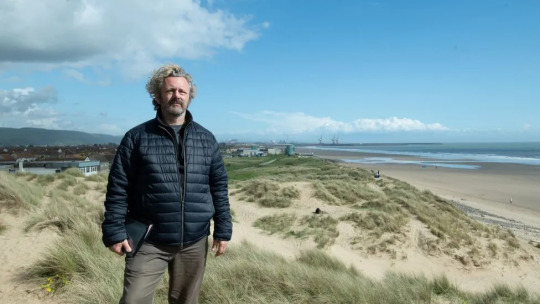
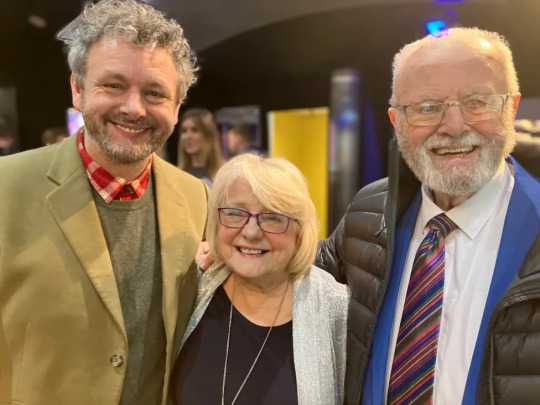
81 notes
·
View notes
Note
I’d like to know more about your swap AU! How did Walter, Dana, Janine, and Louis become the Ghostbusters in this timeline? Who invented & built the equipment? And what roles do the original guys play?
Oh yay, thank you for asking! That's very kind of you to do :]. Sorry for the slower response, I've been all over the place, lol.
Going to split into three-ish sections so it's easier to process but, a quick note is that characters still maintain the core components of their personalities and behaviour - so some of the jobs/experiences that bestowed the Ghostbusters with the capacity to perform their roles are a little altered to fit the alternative four!
I'm also going to toss it under a read-more because knowing myself, I'll go on an absolute screed, lol.
How did they become the Ghostbusters?
Okay, so initially, these characters were not interested in the paranormal (beyond Louis, later on), as all are very straightforward and logically minded and are not inclined towards supernormal explanations. However, Dana and Peck, who met in college and ended up sharing an apartment afterwards, were inspired to look into the concept after an encounter with a poltergeist in their 20s. Which caused them to lose a security deposit and kicked off their desire to both prove the existence of the supernatural and to prevent them from causing more inconvenience or harm to others. It's less out of a desire for understanding and a little more for control with them. Neither feels safe living in a world with unmitigated ghost activity, lol.
Peck and Dana (now older) conducted a lot of their first tests for their initial models on the campus for Columbia University where Dana is studying for her chemical engineering PhD, (one of her avenues of research was on the chemical composition of the supernatural and how they can be contained with man-made materials). They eventually meet Janine here, as she worked at Columbia as a sociology professor and was interested in their strange shenanigans. But their consistent use and destruction of university property got them in enough trouble to be booted from their facilities, Janine alongside them as an 'instigator' and 'enabler'.
After this, they make contact with and catch their first ghost, then the Ghostbusters form "officially" in much the same way as they do in canon.
Louis is the newest employee, a man who wanted to switch careers after becoming disillusioned and bored in his accounting position. He's very keen to learn about ghosts and is actually the member who begins to categorise and label them. He tends to be handling the PKE meter, goggles and sniffer, as he does not do swell lugging the pack about for extended periods (he does occasionally arm himself with someone else's wand, as long as they are wearing the pack itself).
Who constructed the equipment?
This one is a litttttleeee up in the air still, but I've honed in on Peck and Dana for the most part. In this little universe, they have become more technically-minded portion of the team! Peck has a degree in environmental/agricultural engineering and had a particular inclination towards the mechanical aspects of engineering, his initial plan to become an EPA officer fell through (because of his caustic personality) and so he spent his time post graduation tinkering about while working crummy odd jobs. He can jerryrig parts together with shocking ease and is responsible for most of the external components of the equipment. He's not as invested in the spirits the others are, but can construct large swathes of the technology Dana blueprints or conceptualises.
Dana, conversely is responsible for most of the internal wiring and components. As mentioned in the prior answer, she has a biochemical inclination.
What are the other four up to?
They've all filled in for the 'now Ghostbusters' four in some regard, while not exactly one-to-one they are in the same 'place' within the plot.
Peter is functionally Dana. He is haunted and possessed by Zuul, though unlike canon-Dana, he is aware of the haunting but mostly blasé about it. He is still a flirt, but the pursuit between him and Dana is kind of backwards I.E. he invites her to his house to investigate Zuul and then does his whole leering thing towards her that way. I actually have a scene concept wherein she's so sick of being invited that Peck and Louis go instead to try to ward him off a little. Much to his chagrin. "You're not Dana -" "We're Ghostbusters, you called the Ghostbusters, no?". Ray wants to be his buddy, but Peter is very smarmy, uninterested, and Venkman-esc about it. He plays double bass in an orchestra, inspired by the plucking thing he does with Dana's cello in GB2, and also teaches strings.
Ray is filling in for Louis, still socially overeager but unfulfilled. Possessed by Vinz. He's not necessarily attracted to Peter but is instead rather keen on forming a friendship that Peter does not reciprocate much. Narratively, he'd end up joining the Ghostbusters like Louis does in 2. At the time of the story, he's a bookstore employee/manager and is very passionate about his work.
Winston is Janine's equivalent, he's has a lot less of a biting/snarky personality but very much holds his own as a secretary. He decided in-universe that he wanted a break from hard work after his military stint and so opted for desk work - this does not go entirely to plan as the GB secretary job is very demanding, lol.
Egon kind of ends up as Peck. He's an EPA agent, but because his canon personality carries over, his no-nonsense and rule orientated decision-making is more out of genuine protection of the city and environment and not very ego based. He's just a strong stickler for regulation and also.., Peck rubs him the wrong way bc Peck is a vain bastard who refuses to comply with any investigation. Which is the catalyst to his intense investigation. He's very stern and (usually) less incendiary, but he will not back down when he figures what the Ghostbusters are doing is dangerous.
13 notes
·
View notes
Text
one of my friends in the "aw shucks, hux" server has DA:V and made a rook that looks just like hux, so naturally i was inspired to make a sort-of-angsty DND AU where armitage is a half-elf artificer
his father brendol, a high elf military officer descended from a patriar of baldur's gate, fathers him with one of the women who works in the kitchen on his expansive manor, a human named soairse
saoirse loves baby armitage sooooo much!!! she loves his ginger hair and green eyes, even his cute little ears. when he's a little baby, she carries him in a sling on her back while she works. (baby armitage loves this)
brendol and maratelle, another high elf, begrudgingly allow her to keep him given that brendol and maratelle have tried and failed to have their own children which would leave the hux estate without an heir
then, in order to ensure that any and all of his property remains within the family, he betroths a toddler armitage to the newborn daughter of another noble elven family—another half-elf.
brendol sends him to one of the finest academies in faerûn—reminding him the entire time that he better make the tuition money worth it.
armitage shows amazing prowess at design and mathematics. he can take apart a machine and put it back together again without ever looking at the blueprints. this garners him attention from his father's grand admiral, rae sloane. she takes him under her wing and gets him into specialized artificer apprenticeships, bringing him all the way to the position of chief engineer of the faerûnian military.
along the way, he internalizes brendol and maratelle's prejudice against half elves as well as their low opinion of anyone outside nobility. he overachieves in school, his apprenticeships, and in how tightly he holds to his family's noble traditions, etiquette, and values. it was beaten into him daily, how could he ever forget?
he develops a special kind of loathing for brendol because of it. it isn't just the abuse, but that brendol would keep him from shining brighter just because his son's human ancestry is "shameful" to the hux name. if armitage has a chance to take one step up, brendol pushes him back down. maratelle punishes him in a different way—she abuses his mother instead. maratelle will force her to work through any ceremonies armitage is a part of, or banishes her to the servants' housing for days without reason. he develops a certain ruthlessness, thinking that if he can just go far enough, he'll finally be able to get out from under his father.
rae sees it too. she sees how her junior officer batters his son into high achievement. she sees how she sabotages him. who is this underling to be fucking with the hard work she's put into raising armitage into the man he is? he must be dealt with. and armitage agrees. if he had control of the estate, he wouldn't have to answer to brendol or maratelle anymore. there's no limit to what he could do, not just with the money but with nobody over him waiting to get his neck under their boot.
when armitage is older, roughly in his thirties, he's on the shortlist to be appointed chief engineer of the faerûnian military and one of five top strategists for the flaming fist. rae knows that brendol has plans to sabotage him, so she gets to him first. brendol dies in a military training 'accident' about a month before the appointment. maratelle dies from a 'mysterious illness' a week after.
in the span of a fortnight, armitage inherits the title of chief engineer, strategist, and master of the hux estate. there's just one problem: he needs to be married and he is, currently, very very single.
4 notes
·
View notes
Text
On Monday, the leadership of the Screen Actors Guild–American Federation of Television and Radio Artists held a members-only webinar to discuss the contract the union tentatively agreed upon last week with the Alliance of Motion Picture and Television Producers. If ratified, the contract will officially end the longest labor strike in the guild’s history.
For many in the industry, artificial intelligence was one of the strike's most contentious, fear-inducing components. Over the weekend, SAG released details of its agreed AI terms, an expansive set of protections that require consent and compensation for all actors, regardless of status. With this agreement, SAG has gone substantially further than the Directors Guild of America or the Writers Guild of America, who preceded the group in coming to terms with the AMPTP. This isn’t to say that SAG succeeded where the other unions failed but that actors face more of an immediate, existential threat from machine-learning advances and other computer-generated technologies.
The SAG deal is similar to the DGA and WGA deals in that it demands protections for any instance where machine-learning tools are used to manipulate or exploit their work. All three unions have claimed their AI agreements are "historic" and "protective," but whether one agrees with that or not, these deals function as important guideposts. AI doesn't just posit a threat to writers and actors—it has ramifications for workers in all fields, creative or otherwise.
For those looking to Hollywood's labor struggles as a blueprint for how to deal with AI in their own disputes, it's important that these deals have the right protections, so I understand those who have questioned them or pushed them to be more stringent. I’m among them. But there is a point at which we are pushing for things that cannot be accomplished in this round of negotiations and may not need to be pushed for at all.
To better understand what the public generally calls AI and its perceived threat, I spent months during the strike meeting with many of the leading engineers and tech experts in machine-learning and legal scholars in both Big Tech and copyright law.
The essence of what I learned confirmed three key points: The first is that the gravest threats are not what we hear most spoken about in the news—most of the people whom machine-learning tools will negatively impact aren’t the privileged but low- and working-class laborers and marginalized and minority groups, due to the inherent biases within the technology. The second point is that the studios are as threatened by the rise and unregulated power of Big Tech as the creative workforce, something I wrote about in detail earlier in the strike here and that WIRED’s Angela Watercutter astutely expanded upon here.
Both lead to the third point, which speaks most directly to the AI deals: No ironclad legal language exists to fully protect artists (or anyone) from exploitation involving machine-learning tools.
When we hear artists talk about fighting AI on legal grounds, they’re either suing for copyright infringement or requiring tech companies to cease inputting creative works into their AI models. Neither of these approaches are effective in the current climate. Copyright law is designed to protect intellectual property holders, not creative individuals, and the majority of these infringement lawsuits are unlikely to succeed or, if they do, are unlikely to lead to enforceable new laws. This became evident when the Authors Guild failed in its copyright lawsuit against Google in 2015; and it faces similar challenges with its new suit, as outlined here.
The demand to control the ability of AI to train on artists' work betrays a fundamental lack of understanding of how these models and the companies behind them function, as we can’t possibly prevent who scrapes what in an age where everything is already ingested online. It also relies on trusting tech companies to police themselves and not ingest works they have been told not to, knowing it’s nearly impossible to prove otherwise.
Tech entities like OpenAI are black boxes that offer little to no disclosure about how their datasets work, as are all the major Big Tech players. That doesn’t mean we shouldn’t fight for greater transparency and reform copyright protections. However, that’s a long and uncertain game and requires government entities like the US Federal Trade Commission to be willing to battle the deep-pocketed lobbyists preventing meaningful legislation against their Big Tech bosses. There will be progress eventually, but certainly not in time for this labor crisis that has hurt so many.
The absence of enforceable laws that would shackle Big Tech doesn’t make these deals a toothless compromise—far from it. There is great value in a labor force firmly demanding its terms be codified in a contract. The studios can find loopholes around some of that language if they choose, as they have in the past, but they will then be in breach of their agreed contract and will face publicly shaming lawsuits by influential and beloved artists and the potential of another lengthy and costly strike.
What is historic in these Hollywood deals is the clear statement of what the creative workforce will and won't tolerate from the corporations. Standing in solidarity behind that statement carries tremendous weight, even if it isn't fully enforceable. It sends a message to other industry unions, several of which are facing upcoming contract negotiations, and to all labor movements, that workers will not tolerate being exploited and replaced by the rapid advance of Big Tech. And it should not be lost on the AMPTP that it may soon find itself making similar demands for its own survival to the Big Tech companies, who are perfectly poised to circumvent or devour the legacy studios.
Over the weekend, there were calls for SAG members to reject the contract based on its AI stipulations. I'll be voting to ratify, as I did for the DGA and WGA agreements—not because the terms are perfect or ironclad but because the deal is meaningful and effective. And there are no practical and immediate solutions that aren’t currently addressed. It’s time to get back to work.
This is not a fight that ends with the current strike; it’s early days in the Tech Era, with both painful disruption and significant benefits to come. The SAG deal, in combination with the DGA and WGA deals, is a momentous early blow in labor’s fight for a fair and equitable place in the new world.
25 notes
·
View notes
Text
By: William Deresiewicz
Published: Nov 21, 2024
The politics of the academy have been defeated. Its ideas, its assumptions, its opinions and positions — as expressed in official statements, embodied in policies and practices, established in centers and offices, and espoused and taught by large and leading portions of the professoriate — have been rejected. This was already evident before November 5. It can now no longer be denied.
Some data points: A post-election survey from Blueprint, a Democratic polling firm, discovered that, among reasons not to vote for the Democratic presidential nominee, “Kamala Harris is focused more on cultural issues like transgender issues than helping the middle class” ranked third, after only inflation and illegal immigration. Among swing voters, it ranked first. California approved a ballot measure to stiffen penalties for theft and drug crimes by a margin of 69-31. Los Angeles elected a former Republican as district attorney over the progressive incumbent by 61-38. Alameda County, which covers most of the East Bay including Berkeley, recalled its progressive DA by 63-37. Portland, Ore., elected a former businessman as mayor over the leading progressive candidate by 18 points.
We’ve seen comparable results in recent years. In 2020, California rejected affirmative action by 57-43. In 2021, Seattle elected a Republican city attorney over a police abolitionist, New York City elected Mayor Eric Adams — despite his manifest deficiencies — on a law-and-order platform, and Buffalo, N.Y., reelected its mayor as a write-in candidate by 19 points over the socialist to whom he had lost in the Democratic primary. In 2022, San Francisco recalled three progressive members of its Board of Education by lopsided margins, then recalled its progressive DA.
Survey findings tell the same broad story. A Marist poll this year revealed that 57 percent of Latinos surveyed are in favor of deporting all illegal immigrants. A Pew poll showed that 75 percent of Black respondents and 85 percent of Latinos are in favor of voter ID laws. After the Supreme Court banned affirmative action in college admissions, Gallup found that 52 percent of Black and 68 percent of Latino adults supported the decision. Another Pew poll, consistent with earlier findings, showed that only 4 percent of Latinos use “Latinx,” and that of those who have heard of the term, the vast majority reject it. And then there are perhaps the most important data points of all. Donald Trump increased his support among Black, Latino, and Asian voters from 2016 to 2020, then increased it again from 2020 to 2024 (he also got a majority of the Native American vote). The light was blinking. Now it’s solid red.
Over the last 10 years or so, a cultural revolution has been imposed on this country from the top down. Its ideas originated in the academy, and it’s been carried out of the academy by elite-educated activists and journalists and academics. (As has been said, we’re all on campus now.) Its agenda includes decriminalization or nonprosecution of property and drug crimes and, ultimately, the abolition of police and prisons; open borders, effectively if not explicitly; the suppression of speech that is judged to be harmful to disadvantaged groups; “affirmative” care for gender-dysphoric youth (puberty blockers followed by cross-sex hormones followed, in some cases, by mastectomies) and the inclusion of natal males in girls’ and women’s sports; and the replacement of equality by equity — of equal opportunity for individuals by equal outcomes for designated demographic groups — as the goal of social policy.
It insists that the state is evil, that the nuclear family is evil, that something called “whiteness” is evil, that the sex binary, which is core to human biology, is a social construct. It is responsible for the DEI regimes, the training and minders and guidelines, that have blighted American workplaces, including academic ones. It has promulgated an ever-shifting array of rebarbative neologisms whose purpose often seems to be no more than its own enforcement: POC (now BIPOC), AAPI (now AANHPI), LGBTQ (now LGBTQIA2S+), “pregnant people,” “menstruators,” “front hole,” “chest feeding,” and, yes, “Latinx.” It is joyless, vengeful, and tyrannical. It is purist and totalistic. It demands affirmative, continuous, and enthusiastic consent.
People are fed up, and I don’t just mean people who voted for Trump. A few days after the election, I was listening to The Brian Lehrer Show on New York Public Radio, which was broadcasting one of those endless postmortems that the media has been conducting, when another listener called in. She identified herself as Black, a Berkeley grad, “super liberal,” and a resident of Brownsville, a largely Black neighborhood. Referring to the burden that the influx of asylum-seekers has placed on the city’s resources and therefore on people’s lives (“I’m talking about Black people here, at the lower end of the economic spectrum”), and how you weren’t supposed to talk about it, how if you did talk about it you were accused of being racist, how you weren’t even supposed to notice it, how people were being asked “to engage in a cognitive dissonance that is literally not possible,” she finally said, with beautiful succinctness, “When did liberalism mean no common sense?” It’s clear that many Democrats have been wondering the same thing.
How did things get to this pass? And how did the academy, the school and citadel and engine of this revolution, become so desperately out of touch with reality, including the reality of people’s lives outside the liberal elite, their needs and beliefs and experiences? One answer is that academics tend to live inside a bubble. They socialize with other academics; far more than used to be the case, they marry other academics; and, of course, they work with other academics. When groups whose members are broadly similar in outlook are isolated from external influences, two things happen: Their opinions become more homogeneous, and their opinions become more extreme. Which is exactly what’s been taking place in the academy in recent decades. The ratio of liberals to conservatives has soared, and more of those who identify as left identify as far left. And both of those trends are more pronounced in the fields and institutions that are leading the revolution: the humanities, the social sciences exclusive of economics, the “studies” programs and departments, the schools of education and social work, the elite universities, and the liberal-arts colleges.
The reason that these disciplines can drift so far from reality is that they are not answerable to reality.
Those fields have another thing in common: They are intellectually corrupt. You know what I’m talking about. Any fool idea passes muster, no matter how preposterous, as long as it conforms to prevailing theoretical trends and preferred ideological positions. Nobody wants to make waves: to speak up at a conference, to undermine a colleague or colleague’s student, to invite examination of their own research. Data is massaged; texts are squeezed or bound and gagged. Jargon helps to paper over cracks in logic; countervailing evidence is tucked under the cushions. Standards are ignored to the point where no one can even recall what they are anymore. It’s no wonder that the social sciences are suffering a replication crisis. In the humanities, there is no crisis, because there is no replication to begin with, no factual claims to reproduce, only “readings,” “interventions,” “Theory.”
The reason that these disciplines can drift so far from reality is that they are not answerable to reality. If an engineer miscalculates an equation, the building falls down. But what would accountability to reality even mean in the humanities, given that their findings are never applied? It’s not like there are going to be consequences for saying something stupid about Shakespeare. In the social sciences, and, less often, in the hybrid “studies” fields, findings are applied, but it isn’t clear that there’s much of a feedback loop there either. How many hypotheses in psychology have been abandoned because they led to bad educational policy? How many gender-studies scholars have rethought their suppositions in the face of the calamity of gender youth medicine? The more a field becomes beholden to theory, or Theory, the further it floats away from empirical observation and therefore correction. The enterprise becomes entirely self-referential, words built on words, a kind of intellectual Ponzi scheme.
So how are academics going to respond to their political repudiation? One alternative — the likeliest one — will be to stay the course. The people have spoken, but the people are wrong. They’ve been misinformed and disinformed. They are victims of false consciousness, too benighted to understand their own interests. They are racist, sexist, xenophobic, yearning for a strongman. The attitude reminds me of the few American Communists who were still around when I was young — scientifically certain of everything as they headed ineluctably toward political extinction.
But academics have another option. They can entertain the possibility that they’ve been wrong, about a lot of things and for a long time. They can consider that the notion that Harris lost because of racism and sexism is belied by the fact that we have already elected a Black president; that Harris received a larger share of the white vote than Joe Biden; that a female presidential candidate has already won the popular vote; that the nation, far from distrusting women with executive office, has elected 44 female governors in 31 states; that 16 of those governors have been Republicans, which means that most Republicans supported them; that those states include not only blue or purple ones but Alabama, Arkansas, Nebraska, Oklahoma, South Carolina, and South Dakota; that Kansas and Texas have actually elected Democratic women governors; and that while there are surely people in this country who wouldn’t vote for a woman or nonwhite presidential candidate, they also surely wouldn’t vote for any Democrat. That Harris lost for other reasons altogether.
Trump is appalling, evil, criminal. But the worse he is, the worse the liberal elite must be, if so many prefer him to them.
They might further consider that the majority of Black, Latino, and Asian Americans do not share their politics or ideology; that the people who speak for those communities in elite liberal spaces — not only colleges and universities but the media, the arts, the nonprofits — share the politics and points of view not of those communities but of other liberal elites and therefore do not, in the simplest and most important sense, represent them; that progressives have been promulgating policies in the names of those communities that they reject — for Blacks, police defunding and abolition; for Latinos, lax immigration and border enforcement — and that they reject them for good reasons. That identity is not a very useful way of understanding people’s motivations.
Finally, they might consider that to say that certain people “vote against their interests” is not only condescending but wrong. People know what their interests are. They know it much better than you do. Their interests are the same as everybody else’s: public safety, economic security and opportunity, and on top of that a little dignity, a little respect. And while Trump is hardly likely to advance those goals, the 80 percent of the country that lies below the upper middle class is perfectly justified in doubting whether the Democratic Party, and the elites that run and influence it, will do so either, because for decades they have not. Yes, Trump is appalling, evil, criminal. But the worse he is, the worse the liberal elite must be, if so many prefer him to them.
Ten years ago, I published a book, Excellent Sheep, that argued that the meritocratic elite, which includes the professoriate as well as the academy’s administrative class, had become self-serving, self-perpetuating, and, as leaders of our most important institutions, incompetent. It had lost its authority. It had lost its legitimacy. The time had come for it to step aside in favor of a new, more democratic dispensation. Nine months after the book came out, the rough beast glided down his gilded escalator. A few months after that, a wild-haired septuagenarian socialist almost single-handedly destroyed the Clinton-Obama establishment. One would think the message would’ve been received by now. The message is you failed. Sit down, be humble, and listen and learn.
#William Deresiewicz#academic corruption#corruption of education#academic fraud#critical theory#pseudoscience#woke#wokeness#cult of woke#wokeism#wokeness as religion#religion is a mental illness
6 notes
·
View notes
Text




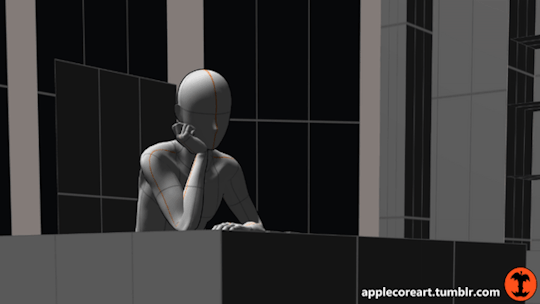
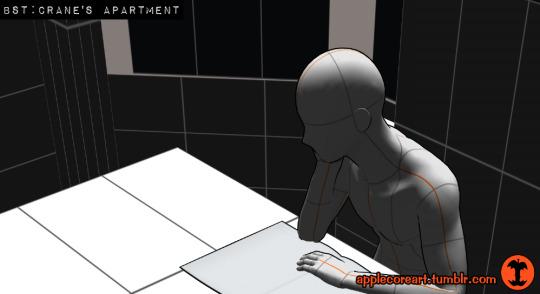
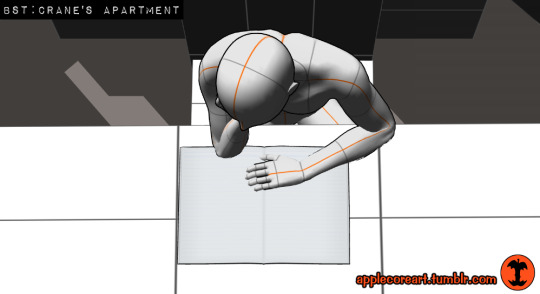

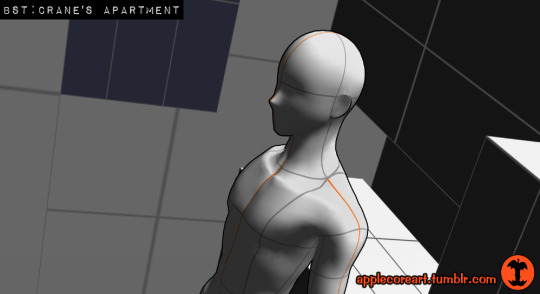
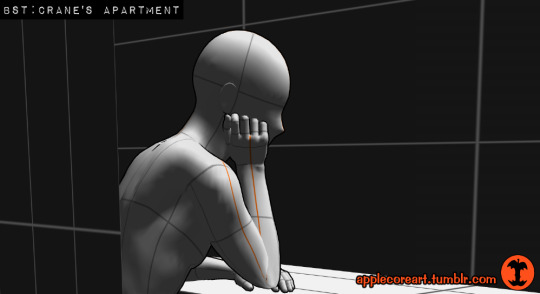
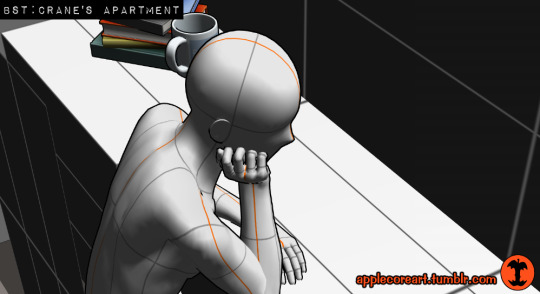

+BST Project: I designed the abandoned apartment Crane is hiding out in using references pulled from properties in NYC via real estate sites. I mashed together apartment layouts I liked and made a blueprint. Still, it’s difficult to grasp scale and proportion in a flat blueprint, especially when drawing backgrounds, so I made a rough 3D blueprint in CSP using primitives and a character model scaled to Crane’s 6'4" height as reference.
It's really helpful to see the whole setting like this and quickly test out camera positions. I’m excited to build more of these for other locations in the future– I had a lot of fun and they’re really satisfying to build and look at :)
Posting just some WIP teaser images for now so people can see what I’ve been up to. At some point I plan to use this model to paint an above shot blueprint with all the textures, features, and furniture as a reference for painting backgrounds.
#BSTproject#RA fanstuffs#had a lot of fun working on this#reminded me of building houses and towns in Lego as a kid#also working with primitive shapes made me reconsider learning Blender for this sort of thing-- less of a learning curve
15 notes
·
View notes
Text
Why Most Property Investors FAIL (And How to Win Big!) | Buy to Build S5 Ep. 3
📉 Most investors make a HUGE mistake—they chase past performance and end up paying full retail! But the real money is made by those who know where to buy BEFORE the boom. Join retired property investor George Markoski as he reveals how to identify high-growth suburbs before they take off and why looking at past trends can cost you big time. In this episode of Buy to Build, George breaks down: ✅…
#Blue Collar investors portfolio guidance#FIFO#High Growth Investments Expertise#High Yield#Negative Gearing Guidance and expertise#Positive Geared Property guidance#Positive Property Blueprint#Property and Investment Portfolio Mentoring#Property Investing
0 notes
Text
The Angel and The Unholy
I want to thank @earthlyangelbby for beta reading this. All mistakes are still my own.
Chapter 2 - Surface Knowledge
Summary... A little in Eddie's perspective to show how well the Carrier family has been accepted into Hawkins. As well as the first tutor session between Eddie and Victoria.
I hope you enjoy and please let me know if you liked this at all.
.....
Eddie looked over at Victoria, not being able to help himself.
She was smiling, talking with a few others. Eddie wondered if there was anyone she didn’t talk to because everyone would. The band geeks, science nerds, cheerleaders, jocks, and even the ones who partied. She talked to all who crossed her path, especially people who she could help. Some of the people who talked to her were others who were enrolled in tutoring. Mrs. O’Donnell spoke highly of her and maybe she could help him.
Maybe he could learn more about her too…
Victoria was sitting with the group of band geeks right now…Talking just as animatedly with Robin Buckley about something with that radiant, trance inducing, gorgeous, perfect smile…
Then Eddie watched as Nancy Wheeler asked her a question and then Victoria smiled as she gathered her things. They moved towards the doors of the cafeteria room. Nancy holding a sheet of paper to her. The answer was clear what that paper was when Victoria grabbed her red folder she kept specifically for food orders to give to her mother, Sylvia, and grandmother, Echo.
Dustin tapped Mike’s arm frantically. “Is she talking to your sister?”
Mike spoke quickly, “is she ordering more cookies?!-”
Dustin was up and pushing Mike towards them. “Gogogogo!”
Eddie watched the two freshmen rush towards Victoria and Nancy, their eyes hopeful and quickly talking over Nancy who looked annoyed at the interruption. Victoria laughed, the sound reaching Eddie’s ears and making him want to smile. She nodded to the young boys and they cheered unashamed.
Gareth mumbled, “think they will share with us again?”
Eddie silently hoped to get another taste of the cookies. No one could describe the amazing way the food tasted because it tasted out-of-this-world good.
The Carrier family was quickly, lightspeed fast, making a positive name for themselves.
The brother, Andy, a fucking mircale worker as the towns new handy man that could fix anything. He had a quick solution to nearly every problem, making him the new ‘first to call’ for any issue. If he could get his hands on something that broke, he could fix it. He stopped to help people whose car broke down on the side of the road and tried to at least mend the issue so they could get home. He could fix the hardware of any appliance.
He proved his skills in blueprints and constructing houses on their own property.
The house that the zombie boy lived at, that was where the new family lived. Andy completely changed the property and used only a few contractors, choosing to do the work mostly between himself and the family. Added a second story to the house, installed a greenhouse, renovated some space for cooking purposes and food storage.
Mike and Dustin were there a few times to pick up an order or few with Nancy and they couldn’t stop talking about how much the property had changed in the short time they lived there.
All of the family members have proven to be self reliant, never asked for help but ready to do anything to help others, they were all compassionate and selfless.
As well as righteous.
The head of the family? Mr. Carrier. He was a lawyer, and a damn good one. Hardly lost a case.
They were the perfect family…
All Eddie had was his uncle Wyan and a bad reputation from his father. Known as the TOWN freak for his taste of music, and hobbies. Dealt drugs for his money that already got him a criminal record. Third time trying to pass senior year… So he was perplexed as to why he had the extreme fascination with her. He wondered why the hell he signed the paper for tutoring but it just felt right. It felt like his chance to learn more about her. The idea was stupid as shit. All because she knew he suffered academically enough for a teacher to push tutoring onto him.
Excellent grades must be a part of the demand within the family because Victoria was not at the school long, almost a month, and tested amazingly enough to be accepted into the tutoring program. Teachers loved Victoria and her sister, Natalia.
While it seemed the family was settling in for the foreseeable future, Eddie was sure Victoria would leave. She seemed like the type that had a bigger life than a simple small town. Get a fancy degree and be off to whatever perfect dream job she wanted.
Eddie dreamed of getting out of this small town, and hit it off big with his band, and experience all the crazy and amazing shit that rockstars did. He wouldn’t be the freak of the town, he would be adored by his fans for being the metal head he was.
Victoria was welcomed by all, helped all.
Eddie brought in his little lost sheep and gave them understanding to embrace who they were. Nerd and weirdness completely accepted by him. He took every chance to try to prove to the students of Hawkins High that stereotypes and people in those confined little boxes were hiding pieces of themselves. Vital pieces that would fester until they exposed themselves to the so called friends of school, only for them to run away and abandon friendship. Either way, most of these people would never see the other as soon as they got the diploma. Off to college or a new location for a fresh start.
The bell rang and maybe tutoring could be the fresh start he needed.
He thought of one word with a snort. Doubtful..
Eddie went to his locker to grab the notebook for biology class with Mrs. O'Donnell. He hated this class. Learning about life, only to then do the disgusting dissection later on this year. He couldn’t stand it. People call him a freak and a satanist while he chooses to skip class during that lesson, all while everyone else is excited to dig around in something dead.
Eddie wondered if Victoria would participate in that. She seemed way too nice for something insanely cruel.
Victoria was in her usual seat near the front of the class so Eddie sat in the back. For some reason he hoped for something different but he wasn’t surprised.
Victoria couldn’t even look at him. That actually hurt somehow because she was nice to everyone else… The note he passed to her yesterday was used as the bookmark for his notebook. He read it over as Mrs. O’Donnell’s voice became background noise… Victoria really did seem to give him the same kindness everyone else received. He knew she would have to talk to him during tutoring, she would have to talk to him because how else was he going to learn from her?
For once. He was looking forward to being in the school longer than he needed to. He was going to probably make an idiot of himself, the fact he was thrown into tutoring by a teacher was probably enough… He sighed, holding the note before tucking it away and attempted to take notes.
—-
Victoria bumped her forehead against the locker. The supplies she needed for the tutoring sessions today in her bag hanging off of her shoulder. She knew she had to get to room 203, however… She knew in about an hour, she would be sitting next to Edward Munson.
“I should just go home…”
Natalia scoffed, “call in sick to work when everyone has seen you in good health the rest of the day? Sounds believable.”
“When are you ever help?”
“I help by not sugar coating shit. Shit is shit. It does not change if you try to polish it, just makes it worse to deal with later.”
Victoria grumbled, “Go home.”
“Yeah. I’m going before it gets dark… When are you done today?”
Victoria sighed, throwing her back into the locker… “I should be done around six. Dad knows to pick me up.”
“Good. Should be enough time for you to get ready for tonight.”
“Yeah. I hope I can get some answers tonight. I have offered a lot this last month, even more so within the last week.”
“I noticed. Yours is rivaling Grandmother’s…”
“I got to go.. Get this over with. I need the money anyway.”
“I’ll check in on how things went in a few months.” Natalia winked as she rounded her belly. Crackling in laughter and skipped out of the way as Victoria was going to hit her.
Victoria focused on her sister, felt her energy, then projected the sharp pinch she inflicted on herself to her sister.
Natalia yelped and rubbed her arm. She turned and flipped Victoria the bird. “I’ll tell dad!”
“Not if you want to keep the unfortunate series of events happening to the kid who picked on Max a secret.”
Natalia huffed as she walked away.
Leaving Victoria alone, groaned as she turned around. Heading through the halls to room 203, where Nate sat, starting the homework already. He really struggled with math but Victoria was happy he was trying. Now if he would stop trying to ask her for tutoring somewhere else other than the school, that would be greatly appreciated.
When the time was getting closer to the hour being up he noticed.. “I know that my time is over for this week, is there any way that I could get some extra time. Study at my place, maybe?”
“I have others I tutor and it is easier if I have one location. I only get 3 hours for each person a week.” Victoria got her planner out and the paper for signatures after each session, her proof for payment. “As always, sign here. Then you can schedule for next week.”
Nate signed and filled three separate times for next week. Then wrote something else largely and circled it a few times. “I’m throwing a party on halloween. I’d love to see you there. Booze and all that fun stuff.”
Victoria looked at how he filled every block for that day. In ink. Her mouth opened for a moment as she tried to think of what to say, calmly. “Uh..”
Nate was heavy into partying, and fun stuff meant drugs and whatever else happened between the impaired. Victoria has been to parties before but she didn’t find them all that admirable. Especially because there was always someone intoxicated flirting with her or even putting their hands on her.
Knowing she had a fated waiting for her she never wanted to entertain anyone else. It was a common thought between many of those who had fated that it was almost like stealing another’s love life. Some people look down on those who entertain others. They call those people greedy and unfaithful because they have their person out in the world waiting for them. Even in cases of casual sex it was still looked down on. Sometimes people catch feelings regardless of the talk of “no emotions.”
In rare cases, a casual hook up could become obsessed with and jealous of the fated pair… It has ended in death often enough to be taught as warnings. Often very intricately woven with the sex talk because children outside of a fated pair have happened.
Nate’s question pulled her out of the horror stories she has heard. “Do you drink?”
She enjoyed a drink occasionally, it gave her a little relaxation. “Not often.”
However, at parties it gave her a look into the truth of some people, something about alcohol brings the ugly heads of truth out in people. Made digging for secrets easier.
“I’ll have a lot supplied, and lots of people will show up.”
A weakened mind was easy to manipulate with telepathy.
Victoria offered a smile, she could use that time to dig around. “I will try to make it.”
Nate smiled largely after a moment of realizing there was a glimmer of hope. “If you need help picking out a costume, I could help. Get you into something, cute.”
Victoria took the chance to get out if it was going to be a party like that. “Thanks for the offer but if costumes are a requirement, then I’m out.”
“Then costumes are optional.”
She laughed as humorsly as she could. “You changed your mind quick.”
She put her planner off to the side as she closed it. Then looked at the time then the door where Edward stood. She saw how he looked at her, confusion still evident in his eyes even though he looked at her with awe. Maybe he was just as confused as she was about him.
Why were they paired together?
Nate spoke and pulled her out of her thoughts. “Just want your beautiful face there.”
Edward's eyes changed, anger dancing in his narrowed eyes.
Victoria turned towards Nate. “You do need to go, my next person is here.”
“I don’t believe it, Munson is getting tutoring this year. Is the new tutor worth feeling like an idiot?”
Victoria replied quickly, professionally. “If I truly make you feel like an idiot, then I am not doing my job properly. I apologize for any reason you have come to this conclusion on your own. I will put in a referral for you to be switched to someone better suited.”
Nate scoffed. “That’s not what I meant.”
“I want you to have the best chance at passing this year. That chance is clearly with someone who won’t make you feel terribly about yourself. I am sorry for anything I have done wrong and will see what your options are for another tutor. Have a good rest of your day, Nate.” Victoria offered a smile but she knew it did not reach her eyes because they had the irritation of protective anger burning in them. "I will try to make it to your party."
Nate huffed, leaving with his things.
Victoria gestured to the seat beside her. “Please sit. As I said in our note, I don’t judge. I apologize if he made you feel bad in any way. I won’t tolerate that at all.”
Edward shrugged, “Nah. It’s okay. Third attempt in senior year so I hear it all the time.”
Victoria looked at him, seeing him try to look unaffected but she could see some unease. He kept moving his eyes, rubbing them. She said, “My eyes get irritated sometimes too, try to blink rapidly to attempt to produce some tears for lubrication.”
He looked at her odd so she continued on the right path of conversation. “But, anyway. School isn’t for everyone, nothing is wrong with that.” She pulled out Eddie’s test with a big red F on it, making him sigh at seeing it. “The only people who are going to need to know the specifics of how cells divide are scientists and doctors who monitor that process, with microscopes. I guess teachers do too.”
Edward smiled a little. “Apparently you need to know how cells divide too.”
Victoria shrugged. “I’m just here for the pay because I retain information in an odd way.”
“Care to share your secret, oh wise one?”
Victoria shook her head with a chuckle. “I dig around in their brain.”
Eddie rightfully looked at her confused. Of course he wouldn’t understand telepathy.
She refrased for normalcy. “Find people who are fascinated with a subject and talk to them. Ask questions, dig, you know?”
“The teachers would die if I did that.”
“Lucky for them, I’m here for you to ask the questions you want to know. If I need to, I’ll find out for you. Take notes during class and come to me with questions. For right now, let's go over this test.”
Victoria noticed Eddie was more relaxed after their talk and now she was doing everything in her willpower to treat him like all the others. She kept her hands away from his, refrained from pushing hair away from his face, staring at him too long, and making herself keep on track of the subject.
The time dragged on for that hour as she controlled herself. She wanted to get to know him more. He seemed like a good person, he was polite, friendly.
Victoria looked at the time. “I apologize, but my next person is going to be here soon. I see you tomorrow?”
“Yeah. I got the slot right after school.”
“Yeah. Not many want to get tutoring on Fridays.”
“Do you like to be here on Friday?”
“It is not terrible. Tutoring barely pays anything, but it's the same place as school, so I don't have to walk elsewhere. I also help the little food service going on in my house for some extra cash.”
“Dustin and Mike love your food, thankfully brought Hellfire a cookie for each of us last time we had a meeting."
Victoria stated, “the club for that fantasy board game?”
He rose his eyebrows, “You know about Hellfire? Dungeons and Dragons?”
Victoria scoffed. “Everyone talks about it in all the media as if it is worse than ouija boards.”
“Those boards for summoning ghosts?”
Victoria responded causally as she flipped through her calendar. “Not always ghosts so that's why anyone with a working brain stays away from them.”
“What do you mean, not always ghosts?”
Victoria wet her lips and as she realized she fucked up slightly. “You know in the movies. Usually something bad, like, a demon attaches to the ones using it. Haunting them, hurting them.”
“You think demons are real?”
“I think there are many things that have yet to be proven. Many find comfort in a religion or belief in higher entities because they fear the things that are uncommon and unknown. So those who are highly religious see those things as unholy. The fear of things they don't have in their straightline scriptures make them unwilling to understand anything else.”
“You are not religious?”
Victoria paused for a moment, “I was explaining that I do not agree with people who have a closed mind to new things."
Victoria slid the paper for him to sign and offered the calendar. "Sign there by the X, it is the form that I turn in to get payment and proof you were here. And if you want to, you can schedule for next week now or wait until a later time. Mrs. O'Donnell is going to have that quiz on Wednesday. Maybe Monday and Tuesday would be days to consider."
Edward looked at the dates for next week. Then tentatively spoke. "I have a gig at the Hideout on Tuesday night. With my band. Could we do a double on Monday? Is that okay?"
Victoria slid the planner to herself. "I only have an hour available on Monday left. I am done by six." Victoria looked at the clock, the next person was almost ten minutes late and with the importance of tonight she needed to get home. "You still have an hour available this week, out of the three. If you want, I could do it for two hours, tomorrow. Then, that way you could go over everything this weekend on your own and I could see what you need help with on Monday."
"Yeah. Uh.. sounds good."
Victoria pushed the planner to him. "Fill those in and you have 2 remaining hours for next week."
"Are you going to go? To the party?"
"According to the planner I am. Anyway, my next person will be here soon."
He gathered his few things, "Right. I'll see you tomorrow."
"Have a good night, and be careful."
Edward stopped for a moment, a small smile on his lips. "You too."
7 notes
·
View notes
Text
How to animate UI - Scroll text
To animate on Unreal Engine 5, you need to make a Widget User interface blueprint and use a canvas panel and a text like so:

Make sure the text is the child of the canvas and that the text is not inside the canvas.
After when you have made the previous steps, press on animations on the bottom left of your screen.

This should open a animation panel:

on the very left side press on the + animation. This is a area which is like a animation folder pretty much where you can add multiple animations to. For example I made a intro with "Press start".

The default name for one is called NewAnimation, click on that then press track, it should be somewhere on the middle panel on the left side.

When you have pressed track, look back at the properties of the Widget Blueprint where you can see your canvas panel and text and click on text then track again. Doing this will give you the option to track your text

Click on the first one with only "Text".
Hovering over the new TextBlock will give another track like so.

Click on track then select "transform" if you want to move the text for the animation. This will give the default keyframe of where you have placed the text block initially. If you placed the text block above the canvas and want it to go down from above the you would use Position Y. If not you would use position X. These positions can be found on the details panel at the top.

After moving it to the position you want it to be in you want to make sure the timeline on your animation is not at the beginning and somewhere else:

When you have moved the timeline to where you'd like it to be you can press on the diamond shape with a + on the position Y or position X on the right side. Once you have pressed the keyframe it should of added a keyframe to your timeline. If you press Space now the animation will play. A quick tip to simply smooth out the animation is to right click both keyframes and make the easing into cubic auto.
2 notes
·
View notes
Text
More tutorial and scripting improvements
Hey everyone, it's been months since my last dev blog update! As you will hopefully have seen, I recently announced the coming release of GearBlocks into early access for November 9th.
A lot of my time lately was spent preparing for this announcement. The trailer video was the biggest chunk of this work: planning, building content in game (including many new built-in constructions!), capturing footage, and editing it all together. I also improved the Steam store page and website with new screenshots, gifs, blurb, presskit, etc.
Tutorial scenario
I recently took the game to a local indie meetup, and had a few people try out the tutorial scenario. It was really useful and informative to watch people play it in person. The feedback was somewhat sobering though, some found it too complicated and struggled with information overload!
So I made some changes to the tutorial to try and simplify the information presented to players, and added more code to handle edge cases where players were getting stuck.
I've also set up a new build configuration for a special demo build with just the tutorial scenario in it, which I'm planning to use for the Steam Next Fest (coming on October 9th).
Lua scripting
I've continued to improve the Lua scripting interfaces, exposing more properties and methods for manipulating parts and constructions, adding more tool interfaces, and more vector / quaternion math stuff.
Further improvements were made to some of the included script mods, including the builder tool extensions (now with the ability to set / snap the pivot position & orientation, change the manipulators to work in world or local space, etc.)
Kit building
For the trailer video I wanted to show time lapses of some constructions being built. I also want to try creating scenarios where the player follows instructions to build pre-designed blueprint constructions, a bit like building from a model kit.
So I implemented a feature I'm calling "kit building", to cater for both of these situations. Parts can now be assigned a stage index and constructions have an active stage that can be set (where any of their parts in higher stages than the active one are hidden).
I made a script mod tool for setting part stage indices, and previewing a construction's stages. I actually used this tool when capturing for the trailer, just manually advancing through the stages in order, revealing the parts.

I also prototyped a kit building scenario with a simple Lua script to allow the player to advance through a blueprint construction's stages, automatically spawning the parts they need to build that stage. This idea has potential I think, but will need work to make it more user friendly.
Minor demo update
I decided to release another quick demo update, out now with some fixes and other small tweaks:-
Minor UI improvements, including a new "getting started" window that shows some helpful pointers when launching into a new game.
Improved attachment locking undo / redo (single command for multiple attachments).
Bug fixes (including fixing the differential idler gear centre-of-mass again).
4 notes
·
View notes
Text
Clarence Thomas Didn’t Disclose Harlan Crow Real Estate Deal — ProPublica
The purchase put Crow in an unusual position: He now owned the house where the justice’s elderly mother was living. Soon after the sale was completed, contractors began work on tens of thousands of dollars of improvements on the two-bedroom, one-bathroom home, which looks out onto a patch of orange trees. The renovations included a carport, a repaired roof and a new fence and gates, according to city permit records and blueprints.
A federal disclosure law passed after Watergate requires justices and other officials to disclose the details of most real estate sales over $1,000. Thomas never disclosed his sale of the Savannah properties. That appears to be a violation of the law, four ethics law experts told ProPublica.
The disclosure form Thomas filed for that year also had a space to report the identity of the buyer in any private transaction, such as a real estate deal. That space is blank
3 notes
·
View notes
Text
Find Your Perfect Duplex in Bhopal – Luxury, Space & Smart Investment
Are you on the hunt for the perfect duplex in Bhopal? A home that balances luxury, space, and affordability? Well, welcome to the world of Draupadi Constructions, where dream homes don’t just exist in blueprints but turn into reality.

Why a Duplex is the Best Investment in Bhopal
Bhopal, a city known for its serene lakes and rich heritage, is now a buzzing real estate hotspot. With infrastructure booming and connectivity improving, owning a duplex in Bhopal isn’t just a matter of comfort but a smart investment decision. Whether you are a first-time buyer or an experienced investor, a duplex offers the perfect blend of independence and affordability. And if you’re looking for the best duplex in Bhopal, you’ve landed at the right place.
Space, Style, and Sophistication
Let’s face it—space is a luxury, and with vertical living becoming the norm, a duplex stands tall (literally) as a perfect solution. Unlike compact flats, a duplex gives you the freedom to design your home in a way that reflects your personality. Imagine having a private garden, a spacious living room, or even an extra study corner—without the feeling of being boxed in. Our duplexes at Draupadi Constructions are designed keeping in mind modern lifestyles, ensuring a seamless blend of aesthetics and functionality.
Location Matters – We’ve Got the Best Ones!
We all know that real estate is all about location, and our duplexes are strategically positioned in some of the most sought-after areas of Bhopal. Whether you want to stay close to educational institutions, healthcare centers, or shopping hubs, our projects are planned with your convenience in mind. You don’t have to choose between peace and connectivity—you get both!
Cost-Effective Luxury
One of the biggest myths about duplexes is that they burn a hole in your pocket. Not true! At Draupadi Constructions, we specialize in creating homes that are as affordable as they are luxurious. Compared to independent bungalows, a duplex offers you the same comfort with a much lower price tag. Plus, with Bhopal’s real estate prices on the rise, buying now means securing a valuable asset for the future.
A Community You’ll Love
A home is more than just four walls; it’s about the community you live in. When you buy a duplex for sale in Bhopal from Draupadi Constructions, you’re not just getting a house—you’re becoming part of a thriving neighborhood. Our projects focus on creating safe, well-connected, and vibrant communities where families can grow and prosper together.
Customization at Its Best
Every family has its own story, and your home should be a reflection of that uniqueness. Our duplexes come with customization options that allow you to tailor your space according to your needs. Whether it’s a home office, a kids’ playroom, or a spacious terrace garden, you can design your duplex to match your lifestyle.
The Future of Bhopal’s Real Estate
The demand for duplex homes in Bhopal is steadily increasing, and for good reason. The city is expanding, and as more professionals and families move in, the need for spacious yet affordable homes is at an all-time high. Investing in a duplex now means you’re ahead of the curve, securing a property that will only appreciate over time.
Step Into Your Dream Home with Just One Click
So, if you’re ready to upgrade your living experience and invest in the best duplex in Bhopal, Draupadi Constructions is here to make it happen. With top-notch architecture, prime locations, and unmatched affordability, our duplexes redefine modern living.
Visit us at https://draupadiconstructions.co.in/ to explore our latest offerings. Your dream home is waiting—are you ready to step in?
0 notes